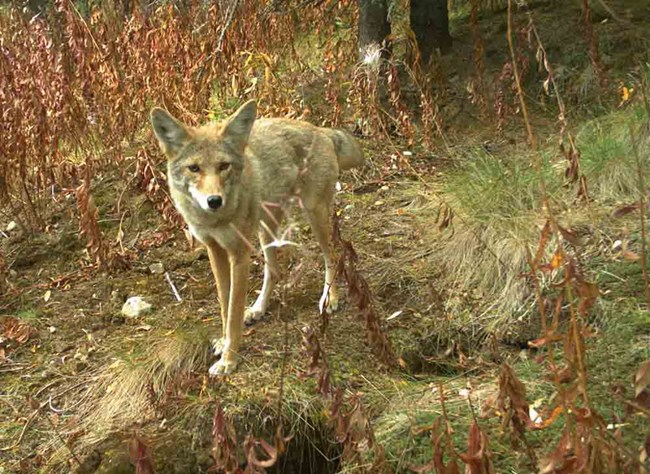Last updated: April 27, 2021
Article
Living arrangements between wolves and coyotes

Coyotes have expanded their range in North America by thousands of miles in the last century, bringing them into new ecosystems. As relatively new arrivals to central Alaska, there is limited information on how coyotes live in this area and particularly how they manage the threat presented by a robust wolf population. In this paper, we used data from GPS-collared coyotes and wolves to examine coyote territory size, survival, and response to wolves. We found that coyotes maintain extremely large territories, averaging over 110 square miles (291 km2), and experience low annual survival (0.50) with large carnivores being the largest source of mortality.
Interestingly, we found that coyotes did not universally avoid wolves. Instead, we found that in the winter coyotes tended to use the same areas as wolves and tended to be nearer to wolves than expected. In the summer, coyotes avoided both nearby wolves and areas of high wolf use. These findings may indicate that wolf presence offers reward as well as risk in the wintertime, perhaps through the creation of scavenging opportunities (though see our complementary paper about scavenging). Alternately, coyotes and wolves may be forced into the same areas in the winter by the need to find efficient travel routes and hunting areas in the deep snow.
Living on the edge: Spatial response of coyotes (Canis latrans) to wolves (Canis lupus) in the subarctic
Abstract
Understanding how mesopredators manage the risks associated with apex predators is key to explaining impacts of apex predators on mesopredator populations and patterns of mesopredator space use. Here we examine the spatial response of coyotes (Canis latrans Say, 1823) to risk posed by wolves (Canis lupus Linnaeus, 1758) using data from sympatric individuals fitted with GPS collars in subarctic Alaska, USA, near the northern range limit for coyotes. We show that coyotes do not universally avoid wolves, but instead demonstrate season-specific responses to both wolf proximity and long-term use of the landscape by wolves. Specifically, coyotes switched from avoiding wolves in summer to preferring areas with wolves in winter, and this selection was consistent across short-term and longer term temporal scales. In the summer, coyotes responded less strongly to risk of wolves when in open areas than when in closed vegetation. We also demonstrate that coyotes maintain extremely large territories averaging 291 km2, and experience low annual survival (0.50) with large carnivores being the largest source of mortality. This combination of attraction and avoidance predicated on season and landcover suggests that mesopredators use complex behavioral strategies to mediate the effects of apex predators.
Klauder, K., B. Borg, and L. Prugh. 2021. Living on the edge: Spatial response of coyotes (Canis latrans) to wolves (Canis lupus) in the subarctic. Canadian Journal of Zoology 99: 279-288.
